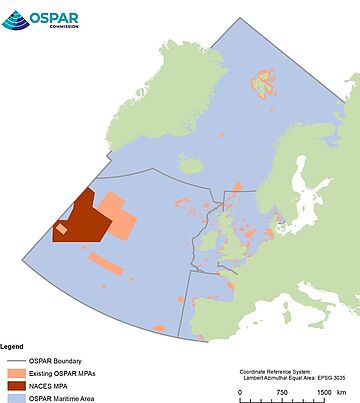OSPAR countries agree on a new 10-year strategy
The environment ministers of the North-East Atlantic countries – the Contracting Parties to the OSPAR Convention – agreed today in Cascais, Portugal on the establishment of a new marine protected area. The area covered is the size of Germany and the United Kingdom combined and will provide protection for seabirds. A new strategy for 2021 to 2030 was also adopted, containing reduction targets and measures regarding pollution from marine litter, hazardous substances and nutrients. The goal is to reduce marine litter on beaches by 50 percent by 2025 and by 75 percent by 2030. 30 percent of the North East Atlantic is to be designated as marine protected areas by 2030. Parliamentary State Secretary Rita Schwarzelühr-Sutter represented Germany at the conference.
Rita Schwarzelühr-Sutter commented: “Our oceans are a habitat for thousands of species. Human life is impossible without oceans. Intact oceans are essential for a healthy global climate. But the world’s oceans are under threat. The exploitation of the marine environment has increased dramatically. Marine biodiversity is mainly suffering from this. It has decreased to an unacceptable level. The levels of nutrient inputs from agriculture, durable microplastics and toxic chemicals polluting the oceans are continuing to rise. This is why the OSPAR countries are committing to binding environmental goals and creating one of the world’s largest marine protected areas. These decisions will support nature conservation and strengthen the resilience of the oceans as a habitat. They will also promote risk prevention for future generations. This is an important signal for the protection of marine ecosystems that sends a global message in the run-up to the UN Biodiversity Conference in Kunming and the Climate Change Conference in Glasgow.”
The conference of OSPAR countries agreed on the establishment of the high-seas marine protected area NACES (North Atlantic Current and Evlanov Seamount) in the North-East Atlantic. It covers almost 600,000 square kilometres and thus is one of the largest protected areas of the world. By designating this protected area, the global goal of conserving at least 10 percent of coastal and marine areas around the world will be achieved (UN Sustainable Development Agenda) for this marine region. In the Atlantic, only the protected area around Tristan da Cunha in the South Atlantic is larger than NACES (with around 690,000 square kilometres). The protected area will first and foremost serve to protect the extremely large number of seabird populations in the region. To this end, the OSPAR Contracting Parties are committing to special protection measures for future scientific, industrial and other economic activities. As a next step, the Contracting Parties have to transpose their decision into national law. Today’s decision also forms the strategic framework for joint activities of the OSPAR countries at European and international level.

Additionally, the environment ministers of the North East Atlantic countries adopted their Environment Strategy for the years 2021 to 2030. It contains quantitative targets for tackling the greatest challenges facing the North East Atlantic: the impacts of climate change, ocean acidification, biodiversity loss and environmental pollution, including plastic waste. The goals apply for all Contracting Parties, which will implement them nationally and jointly at regional level (including EU level). The OSPAR countries will review these goals regularly. In 2021, the EU took an important step with the ban on several single-use plastic products to stop plastic waste polluting the oceans. Additionally, this year Germany extended the scope of its 2019 Packaging Act. In future, the compulsory deposit will apply to all one-way drinks packaging, and takeaway food must be offered in reusable bowls or cups. From 2025, PET bottles have to contain a minimum share of recyclates.
The OSPAR conference also adopted measures to minimise the pollution of the marine environment caused by plastic pellets from industry. They are the base material for numerous plastic products. The uncontrollable loss of the small plastic pellets during transport is a widespread problem. To limit these massive losses, the Contracting Parties plan to develop standards for preventing pellet loss and establish certification systems for the entire plastic supply chain for the first time. They will also expand their joint marine nature conservation efforts to cover more species and habitats, for example kelp forests. These seaweed ecosystems provide a home for a wide range of species and deserve special protection. A further achievement at the conference are the new cooperation agreements with other regions and intergovernmental organisations.
The OSPAR Convention unites 15 North East Atlantic countries and the EU in their efforts to protect the marine environment of the North East Atlantic. The fifteen Contracting Parties are Belgium, Denmark, Finland, France, Germany, Iceland, Ireland, Luxembourg, the Netherlands, Norway, Portugal, Spain, Sweden, Switzerland and the United Kingdom. Ireland is the current chair of the OSPAR Conference. OSPAR began in 1972 with the Oslo (OS) Convention against marine pollution by dumping. It was expanded in 1974 with the Paris (-PAR) Convention to cover marine pollution from land-based sources and the offshore industry. The OSPAR Convention merged, updated and expanded thse two conventions in 1992. The Annex on biological diversity and ecosystems was added in 1998 to cover non-polluting human activities that can have negative impacts on the maritime area.

